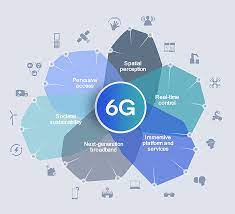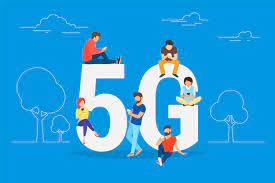
Unveiling the Future: The Promise of 6G Technology
The Future of Connectivity: Exploring 6G Technology
In the ever-evolving landscape of technology, the race for faster and more reliable connectivity never ceases. As we witness the widespread adoption of 5G technology, discussions about the next generation of wireless communication have already begun. Enter 6G – the future of connectivity that promises to revolutionize how we interact with the digital world.
While 5G technology has brought us unprecedented speeds and low latency, 6G aims to take connectivity to new heights. With projected speeds up to 100 times faster than 5G, 6G is expected to enable groundbreaking applications in various sectors, including healthcare, transportation, and entertainment.
One of the key features of 6G technology is its ability to harness terahertz frequencies, allowing for even faster data transmission rates. This opens up possibilities for immersive virtual reality experiences, real-time holographic communication, and seamless integration of artificial intelligence into our daily lives.
Moreover, 6G is set to redefine the concept of connectivity by introducing concepts such as ubiquitous computing and network slicing. Ubiquitous computing envisions a world where every device is interconnected seamlessly, creating a truly interconnected ecosystem. Network slicing allows for customized networks tailored to specific needs, ensuring optimal performance for various applications.
As we look towards the future with anticipation, it is essential to consider the potential implications of 6G technology. From enhanced privacy concerns to increased energy consumption, there are challenges that must be addressed as we transition to this new era of connectivity.
In conclusion, 6G technology represents a significant leap forward in our quest for faster and more reliable connectivity. With its promise of ultra-fast speeds and transformative applications, 6G has the potential to reshape industries and revolutionize how we interact with technology. As we embark on this journey towards a more connected future, one thing is certain – the possibilities with 6G are limitless.
Top 5 Advantages of 6G Technology: Speed, Connectivity, and Innovation
- 1. Ultra-fast speeds
- 2. Low latency
- 3. Enhanced connectivity
- 4. Innovative applications
- 5. Customized networks
7 Drawbacks of 6G Technology: Privacy, Cost, Compatibility, and More
- 1. Privacy concerns may escalate due to the extensive data transmission capabilities of 6G technology.
- 2. Increased energy consumption could pose environmental challenges as 6G networks require more power to operate.
- 3. Compatibility issues may arise with older devices that are not equipped to support 6G connectivity.
- 4. The cost of implementing and maintaining 6G infrastructure could be prohibitively high for some regions or organizations.
- 5. Potential health risks associated with prolonged exposure to higher frequency terahertz waves used in 6G technology need further study.
- 6. Security vulnerabilities may increase as cyber threats evolve to target the advanced network architecture of 6G systems.
- 7. Digital divide could widen if access to 6G technology is not equitable, leading to disparities in connectivity and opportunities.
1. Ultra-fast speeds
With its ultra-fast speeds, 6G technology is poised to revolutionize the way we experience connectivity. Anticipated to provide speeds up to 100 times faster than its predecessor, 5G, 6G will usher in a new era of lightning-fast downloads and seamless streaming. This advancement not only promises to enhance user experiences but also paves the way for innovative applications that require real-time data transmission, setting a new standard for speed and efficiency in wireless communication.
2. Low latency
With its low latency capability, 6G technology is poised to revolutionize the way we experience real-time applications such as virtual reality, augmented reality, and autonomous vehicles. By significantly reducing lag time, 6G enables seamless and instantaneous interactions in these immersive technologies, enhancing user experiences and paving the way for innovative advancements in various industries. The ability of 6G to support these real-time applications opens up a world of possibilities for enhanced connectivity and efficiency in our increasingly digitalized world.
3. Enhanced connectivity
6G technology’s utilization of terahertz frequencies offers a significant advantage in terms of enhanced connectivity. By tapping into these high-frequency bands, 6G can deliver more reliable connections, especially in densely populated areas with high data demand. This means that users will experience improved network performance even in crowded environments, ensuring seamless communication and access to data-intensive applications. The ability of 6G to provide stable connectivity in such challenging conditions marks a substantial step forward in meeting the evolving needs of an increasingly connected world.
4. Innovative applications
The innovative applications enabled by 6G technology will revolutionize various sectors, including healthcare, education, entertainment, and beyond. With its unparalleled speed and connectivity, 6G opens the door to transformative advancements such as remote surgery, immersive virtual learning experiences, interactive entertainment platforms, and much more. By unlocking new possibilities in these fields, 6G technology has the potential to enhance efficiency, accessibility, and user experiences in ways previously unimaginable.
5. Customized networks
One of the standout advantages of 6G technology is its ability to offer customized networks through network slicing. This feature enables the creation of tailored networks that cater to specific requirements, guaranteeing optimized performance for a wide range of applications. By allowing for the allocation of network resources based on individual needs, 6G’s network slicing capability ensures that different services and applications can operate at their peak efficiency, ultimately enhancing overall network performance and user experience.
1. Privacy concerns may escalate due to the extensive data transmission capabilities of 6G technology.
The extensive data transmission capabilities of 6G technology pose a significant con in terms of privacy concerns. With the ability to transmit vast amounts of data at unprecedented speeds, there is a heightened risk of potential privacy breaches and data exploitation. As 6G enables seamless connectivity and real-time interactions, the collection and sharing of personal information may become more pervasive, raising important questions about data security, consent, and surveillance. Addressing these privacy concerns will be crucial as we navigate the implications of this advanced technology in our increasingly interconnected world.
2. Increased energy consumption could pose environmental challenges as 6G networks require more power to operate.
Increased energy consumption could pose environmental challenges as 6G networks require more power to operate. The demand for higher speeds and data transmission rates in 6G technology may lead to an uptick in energy usage, potentially contributing to a larger carbon footprint. As the world grapples with climate change and the need to reduce greenhouse gas emissions, the energy-intensive nature of 6G networks raises concerns about sustainability and environmental impact. Efforts to mitigate the environmental consequences of increased energy consumption in 6G technology will be crucial in ensuring a balance between technological advancement and ecological preservation.
3. Compatibility issues may arise with older devices that are not equipped to support 6G connectivity.
One significant con of 6G technology is the potential compatibility issues that may arise with older devices that lack support for 6G connectivity. As the new generation of wireless communication emerges, older devices may struggle to connect to and benefit from the enhanced speeds and capabilities offered by 6G networks. This could lead to a digital divide, where users with outdated devices may experience limitations in accessing certain services or functionalities available through 6G technology. Addressing these compatibility challenges will be crucial to ensure a smooth transition to 6G and equitable access to its benefits for all users.
4. The cost of implementing and maintaining 6G infrastructure could be prohibitively high for some regions or organizations.
The cost of implementing and maintaining 6G infrastructure could pose a significant challenge for certain regions or organizations. The deployment of 6G technology requires substantial investment in upgrading existing infrastructure and building new networks capable of supporting the advanced capabilities of this next-generation technology. For regions or organizations with limited financial resources, the high cost of 6G implementation may act as a barrier to accessing the benefits of faster and more reliable connectivity. As a result, there is a risk of exacerbating the digital divide between those who can afford to adopt 6G technology and those who cannot, potentially widening existing disparities in access to cutting-edge communication services.
5. Potential health risks associated with prolonged exposure to higher frequency terahertz waves used in 6G technology need further study.
As the development of 6G technology progresses, one significant con that requires careful consideration is the potential health risks associated with prolonged exposure to higher frequency terahertz waves utilized in this advanced communication system. While 6G promises faster data transmission rates and revolutionary applications, the impact of long-term exposure to these terahertz frequencies on human health remains a subject that necessitates further in-depth study and evaluation. Addressing these potential health concerns is crucial to ensure the safe and responsible implementation of 6G technology in our increasingly connected world.
6. Security vulnerabilities may increase as cyber threats evolve to target the advanced network architecture of 6G systems.
As we anticipate the arrival of 6G technology and its revolutionary advancements in connectivity, one significant concern arises regarding the potential increase in security vulnerabilities. With the evolution of cyber threats targeting the sophisticated network architecture of 6G systems, there is a heightened risk of security breaches and data compromises. As hackers adapt to exploit the intricacies of 6G technology, it becomes imperative for developers and cybersecurity experts to proactively address these emerging threats to safeguard the integrity and privacy of users’ data in this new era of connectivity.
7. Digital divide could widen if access to 6G technology is not equitable, leading to disparities in connectivity and opportunities.
The potential widening of the digital divide due to inequitable access to 6G technology poses a significant concern. If certain populations or regions lack equal access to this advanced connectivity, it could exacerbate existing disparities in connectivity and opportunities. This could lead to a scenario where some individuals or communities are left behind in terms of accessing essential services, educational resources, and economic opportunities that rely on high-speed connectivity. Addressing this con of 6G technology will be crucial in ensuring that the benefits of technological advancements are shared inclusively across society.

